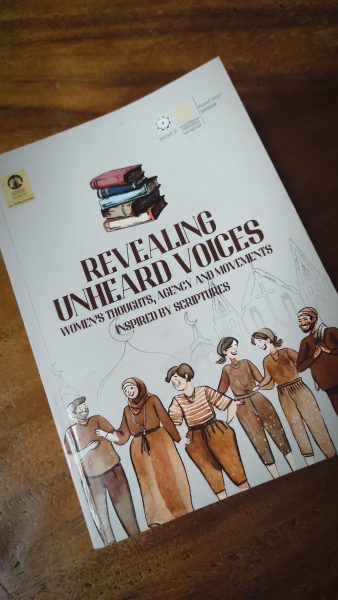Bridging Incompatible Structures Through Pro-women Perspectives
Launching the book ‘Revealing Unheard Voices, Women’s Thoughts, Agency and Movements Inspired by Scriptures’
Ulfa Choironi
Yus Broersma
June Beckx
 In a stormy atmosphere with heavy rain outside, the SIL Building of the University of Indonesia offered warmth inside where enthusiastic participants attended the launch of the book ‘Revealing Unheard Voices, Women’s Thoughts, Agency and Movements Inspired by Scriptures’. The book is the first product of the collaboration between the Netherlands-Indonesia Consortium for Muslim-Christian Relations (NICMCR) Gender Working Group with the Gender Studies Study Program and Gender Research Center of the University of Indonesia (PRG SKSG-UI). The presentation on 5 July 2024, was held following a joint Forum Group discussion of the two institutions in the previous days.
In a stormy atmosphere with heavy rain outside, the SIL Building of the University of Indonesia offered warmth inside where enthusiastic participants attended the launch of the book ‘Revealing Unheard Voices, Women’s Thoughts, Agency and Movements Inspired by Scriptures’. The book is the first product of the collaboration between the Netherlands-Indonesia Consortium for Muslim-Christian Relations (NICMCR) Gender Working Group with the Gender Studies Study Program and Gender Research Center of the University of Indonesia (PRG SKSG-UI). The presentation on 5 July 2024, was held following a joint Forum Group discussion of the two institutions in the previous days.
Iklilah Muzayyanah, who edited the book together with Pokja coordinators Yus Broersma and Christine Hutubessy, recalls that the idea for the book originated at a discussion in one of the lectures at the Gender Studies Study Program at the University of Indonesia, when she was teaching how religion can be viewed from a humanist and feminist perspective, as a counterweight to the perspectives of fanaticism and extremism. The idea also resonated at a NICMCR Gender Working Group (pokja Gender) workshop in 2019, where the participants were invited to present and document their thoughts and experiences on the issue.
Voicing the Taboo with a Humanist Religious Narrative
Moderated by Hutubessy, the event features some of the writers, taking part in the discussions. Religious messages, they claim, should be critically contemplated, thus avoiding potential cause for division and injustice within religious communities. In general, the writers of the book used a feminist perspective as a way of challenging traditional religious interpretations that marginalize women’s own voices. In this way, they emphasized the acknowledgement of the significant contribution of women’s voices in the context of Scripture. This, in turn, would inspire readers to see religion as ‘a gift of love for all beings’ (rahmatan lil ‘alamin).
Muzayyanah illustrates the book as a meeting place, a bridge connecting academics, activists and women’s networks. It provides a platform for serious, honest and meaningful discussions on topics that were previously considered taboo and suppressed in society and religious circles, such as homosexuality, menstruation, the autonomy of the women’s body, etc. The publication is a step forwards towards new ideas and reflections on the social realities within religious communities, aiming to promote justice for women, by countering dominant, patriarchal voices and problematic religious interpretations.
Elaborating on the material, Muzayyanah explains that the book is divided into three major themes, of which in part 1 ‘Alienation of The body and the Trick of Dogma’, the authors describe how they experienced the process of alienation regarding the bodily existence of women and other marginalized groups within the framework of religious perspectives. In Part 2 ‘ Religious Activism Agencies Unraveling of Alienation’, we see how the writers unravel this alienation through self awareness, by advocating for victims of trafficking and of political tragedies, by becoming peace initiators, but also by finding solace with other women’s organizations. In Part 3 ‘Incandescent Hope: a New Direction for Pro-women Policy’, we find that women’s agency has not been in vain. Hope simmers through in new Church policies, new laws favouring women’s issues, and the fact that in Islamic schools in the Netherlands, sex education is no longer taboo but considered part of biology and sociology.
From the analysis of the themes, we can see how women’s voices and experiences can redirect anti-women structures into a new hope for the formulation of religious policies and laws that are pro-women. As the book is a medium for academics and activists, it is hoped that it can be used as a reference for the strengthening of religious issues in feminist movements, both in classroom discussions and in other feminist forums.
Agency of Voice; breaking away from dogma and the independent interpretive approach to religion
An important question from the audience was about our attitude to lay-interpretations of the Scriptures? We see that these interpretations can be used in different and controversial ways and are very difficult to control.
Sahiron Syamsuddin argues that we should always be open-minded, value the opinions of ordinary people and provide space to form their own interpretation. As academics, he says, we have to know what we instill in ourselves of what we understand, and seek to impart this knowledge to the extent of our ability. Muzayannah claims that humanizing all religious adherents must be the starting point in interpreting religion. Education is imperative, teenagers should be educated to become religiously aware and critical, not trapped in norms, but using critical reasoning. This book may serve as a resource for strengthening religious issues within feminist movements, in academic discussions as well as in activists circles. Tafsir, she continues, is a product of thought, be it lay or expert. However, when the interpretation is used to prove the legitimacy of an understanding of a verse, it can become dangerous, because it can lead people perform rituals of worship only symbolically and not substantively. Stebby Julionatan argues that religion should not be understood as subject of dogma, but should always be illuminated by critical thinking. In society, women and children are usually represented by people outside themselves, while the choice to be happy is an individual choice, not chosen or determined by others. In this book, one can read how the writers can have their own definition of happiness, notwithstanding the stigma attached to it, even when it comes to non-heteronormative issues. Sahiron acknowledges that, in the experience of religious institutions, non-heteronormative issues are still highly controversial, not to say taboo. He therefore backs Julionatan’s attempt to restate them, based on the findings of his research, in this case the part relating to Luth’s arguments, which are usually taken as the basis for prohibiting homosexuality. In Indonesia, as a country with a religious majority, this finding has the potential to become extremely controversial. But, he stresses, it is a necessity to fight for and continue to speak up, voicing the truth, supported by strong and rigid arguments. Muzayannah concludes that we are fully aware, that voice articulated in language, can become a space for legitimizing power relations that complicate feminist’ movements, but, she articulates, on the other hand, we also believe that voice can become an agency for the feminist movement’s struggle.
This book aims to encourage deeper, critical engagement with religious narratives, arguing that “Everyone who is religious should be able to understand religion in their own way. Religion is a way of life that contains great values; do not see religion as a dogma that makes us eliminate logical thinking.” It offers readers new interpretations and challenges the idea that feminist and gender activism is incompatible with religious values. Instead, it demonstrates the harmony between religious teachings and feminist efforts, and shows that religion, feminism and gender equality can go hand in hand.
Religious-based women’s voices need to be further developed; it is still assumed that the feminist movement and religion have a conflictual relationship, as both have exclusive attitudes towards each other.
Limited access to the book can be viewed here: https://rb.gy/j12bc8
